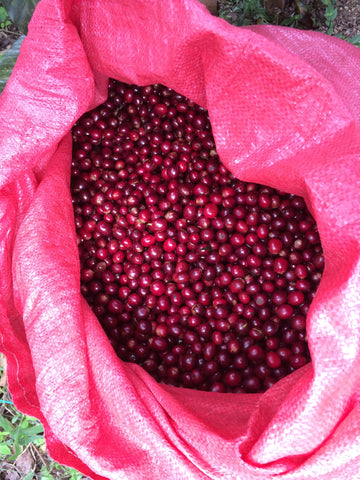

Foundry Santa Maria De Lourdes – Nicaragua
Sorry, this product is not available
If you would like to find out more, please contact us
Getting product details...

This is beautiful coffee and is suited particularly to Aeropress and other filter brewing methods. There are sweet currant notes alongside spicy orange marmalade. Full bodied and creamy and we all thought that there was something akin to Christmas pudding left on the tongue! It’s a complex yet well balanced coffee, rich and rewarding. Our adventures brewing this coffee are only just beginning, it still feels like there is plenty to discover.
Read more about the farm, the region, and Nicaragua as a coffee producing country - courtesy of Falcon, green coffee importers in the north of England:
The coffee industry in Nicaragua has undergone periods of turmoil that have hindered the development of the speciality sector in the country. Many experienced coffee farmers fled during the years under Sandinista rule of the late 1970s to the 1990s. When the political scene changed, those farmers returned and not long after, Nicaragua started to produce some very good coffee. However, the devastating effects of Hurricane Mitch and the prolonged world coffee price crisis created further giant -sized hurdles for a country that can, and now does, produce some very desirable coffees indeed. Key growing regions include the mountainous regions of Matagalpa and Jinotega though it is Nueva Segovia that is heralded as Nicaragua’s premier growing region, particularly the Cordillera de Dipilto – Jalapa – a mountainous region which runs along the Honduran border. Time after time it is this region which produces Cup of Excellence winning lots, for the farms here are blessed with high altitude and excellent climatic conditions. The close proximity of the mills also proves to be highly advantageous in terms of quality protection.
CATURRA: Caturra is a cultivar from Brazil and is a mutation of Bourbon which is much higher yielding. The tree will not reach the same height as Bourbon and typical characteristics associated with this varietal are bright acidity and medium body.
CATUAI: This varietal is a hybrid of Mundo Novo and Caturra and is highly resistant to natural elements that coffee trees face at higher altitudes. It originated in Brazil but is now widely planted throughout Central America. Both the red and yellow strains demonstrate high acidity.
JAVANICA: It is believed this varietal is related to Typica due to the elongated shape of the beans it produces. It has many African cup characteristics such as complex floral and lemon notes with fantastic sweetness.
The municipality of San Fernando is located around 24 kilometres from the region’s capital ‘Ocotal’ and of the 10,000 residents, the vast majority are coffee farmers. This beautiful area is home to Santa Maria de Lourdes. Situated in the Nueva Segovia region at altitudes ranging from 1350 to 1550 metres above sea level, Santa Maria de Lourdes embodies a diverse range of luscious vegetation and wildlife brought about by high levels of annual rainfall.
The 50 hectares of natural mountainous forest has been under the ownership of Octavio Peralta since 1970, though for many years the area was used as war land during the Sandinista uprising and was heavily mined. The UN cleared the area of mines in the late 1980’s and Octavio began to restore exceptional coffee production to this relatively wild area in 1994. Octavio has been dedicated to this cause as well as preserving the natural habitat which is recognised as a main factor in the production of his fantastic coffee. Of the 80 hectares of available arable land, 40 have been set aside for the sole purpose of maintaining and improving the natural habitat. The climate at Santa Maria de Lourdes is much more humid which means the coffee trees are more sparsely planted to ensure everything is properly aerated.
The farm has achieved Rainforest Alliance certification in recognition of this decision and contributes towards the on-going conservation of the surrounding area. There is also a well equipped kitchen which caters for the 60 permanent workers and 150 pickers during the harvest. The general manager is Gladys Gutierrez who oversees the running and upkeep of the farm and is instrumental in the production of high quality coffee. The varietals found here include caturra and catuai as well as the heirloom varietal known as ‘Javanica’. Ripe cherries are handpicked and sorted between December and March. There is a wet mill on the farm where the ripe red cherry is deposited and weighed from each picker. The cherries then enter floatation tanks where ripes and unripes are separated by density. The selected cherries are then pulped in an Eterna depulper to remove the skin from each fruit before the sticky pulped beans enter fermentation tanks for between 14 and 18 hours. They are then washed in channels to remove the sticky mucilage. The washed beans are then taken to the drying patios at the nearby mill of San Ignacio where they are regularly turned by rake to ensure good, even drying. The overall drying process will take around 10 to 12 days.
Farmer: Octavio Peralta
Great for: Aeropress, Filter
Origin: Central America/Nicaragua - San Fernando, Nueva Segovia
Process Method: Washed - and patio dried
Rainforest Alliance:
Tasting Notes: Sweet currant notes alongside spicy orange marmalade. Full bodied and creamy.
Varietals: Caturra, Catuai and Javanica
Roasterr: Foundry Coffee Roasters
Foundry Coffee Roasters does not deliver to United Kingdom
Initial collection: Foundry Coffee Roasters - Sheffield
Tasting record
| Method | Dose | Grind | Time | Volume | Comments |
|---|---|---|---|---|---|
| e.g. Espresso | 18g | Vario 1E | 25secs | 30ml | A bit finer next time would be better. |


